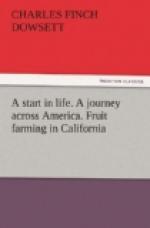In the early morning of December 5th we ran into Ogden, which is near Salt Lake, at the base of the Wasatch Mountains, which are snow-capped, and have some very fine peaks. Salt Lake is 126 by 45 miles, and on it is situate the great City of the Mormons. On the more fertile parts of the prairies I gathered, at Humboldt Wells, some of the sage grass which used to be the food of the buffaloes when they existed; at other places I gathered samples of herbage on less favoured soils. As we proceed, we see an encampment of Indians with red paint on their faces, which was put on to show sympathy with, and, if necessary, take part with other tribes of Indians, then commencing a “war” with the United States soldiers. This district was not far, as distances go in America from the scene of action. Presently we commence our run through the great barren alkali plains, emerging from which we get into a more fertile country, and, at Cedar Pass, notice the great ranch of Messrs. Sparks and Tinnin, who are reputed to have 100,000 head of cattle. Mr. Byrne, of Elko, Nevada, also the owner of a large ranch, was on board the cars, and gave me some useful information. He said that cattle raising is very profitable, as they double in number every four years, i.e., a profit of 25 per cent.; thus, if a man start with a 1,000 head of stock cattle, he will have 4,000 head in four years.
If a thousand head of stock cattle were purchased off a ranch, they would be sold just as they run, without any selection whatever—steers, heifers, cows, calves, bulls, yearlings, both sexes and all ages, but calves which still suck their mothers are not counted, and go for nothing. Many head of cattle perish in the winter, when the land is covered with snow, as on many large ranches no food is given them. I urged that it would pay to have stock-yards and give food during the snow time, and Mr. Byrne said that he always did so himself, and that the great ranch men were having their eyes opened to this necessity.




